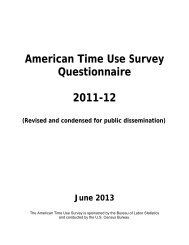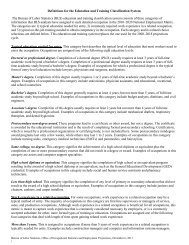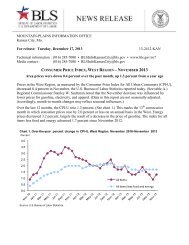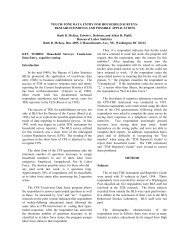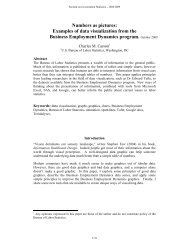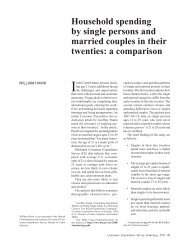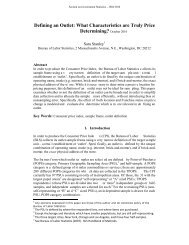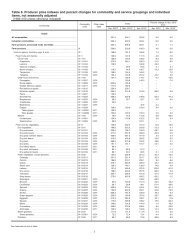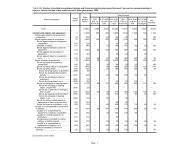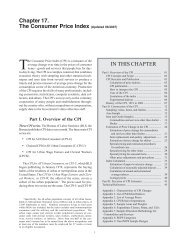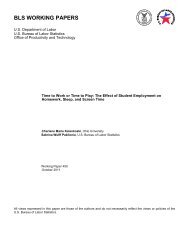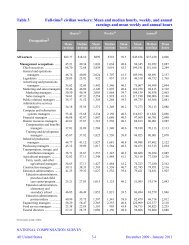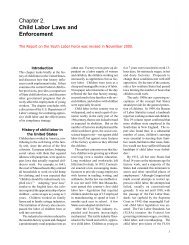The decline of employer stock as a 401(k) investment vehicle
The decline of employer stock as a 401(k) investment vehicle
The decline of employer stock as a 401(k) investment vehicle
You also want an ePaper? Increase the reach of your titles
YUMPU automatically turns print PDFs into web optimized ePapers that Google loves.
employment <strong>of</strong> people with disabilities, but they argue<br />
that the major data sources (from the CPS, the SIPP, and<br />
the National Health Insurance Survey) all produce highly<br />
correlated employment series, so we can in fact identify<br />
trends in the overall employment level <strong>of</strong> people with disabilities.<br />
28 Although their re<strong>as</strong>oning is quite convincing,<br />
sometimes specific numbers, rather than trends, are needed,<br />
and sometimes also specific subgroups <strong>of</strong> the disabled<br />
population need to be identified.<br />
Implications for research and policy<br />
All the studies reviewed in this article expressed some<br />
concern with the data that are available to analyze employment<br />
status for people with disabilities. <strong>The</strong> primary<br />
issue is me<strong>as</strong>uring disability status appropriately, rather<br />
than me<strong>as</strong>uring employment status. However, additional<br />
insights might be gained by paying more attention to what<br />
Schur refers to <strong>as</strong> “nonstandard jobs” (part-time jobs, temporary<br />
situations, and independent-contractor work), <strong>as</strong><br />
well <strong>as</strong> by focusing more on the situation <strong>of</strong> people who are<br />
not in the labor force (for example, whether such people<br />
want to work, whether they are available to work, whether<br />
they have searched for work in the p<strong>as</strong>t 12 months, and<br />
the re<strong>as</strong>ons they have not searched for work).<br />
<strong>The</strong> data that are available appear to be adequate for<br />
identifying trends in employment patterns for people<br />
with disabilities, but they are clearly inadequate for <strong>as</strong>sessing<br />
the impact <strong>of</strong> acts such <strong>as</strong> the ADA. Because the<br />
consensus definitions <strong>of</strong> disability go beyond impairments<br />
and include activity limitations, such <strong>as</strong> work limitations,<br />
research is needed to better show how various impair-<br />
Notes<br />
1 See Richard V. Burkhauser, Andrew J. Houtenville, and David C. Wittenburg,<br />
“A User’s Guide to Current Statistics on the Employment <strong>of</strong> People<br />
with Disabilities,” in David C. Stapleton and Richard V. Burkhauser (eds.), <strong>The</strong><br />
Decline in Employment <strong>of</strong> People with Disabilities: A Policy Puzzle (Kalamazoo,<br />
MI, Upjohn Institute for Employment Research, 2003), pp. 23–86.<br />
2 Definition cited from the glossary at the BLS Internet site www.bls.gov/bls/<br />
glossary.htm (visited June 5, 2008). <strong>The</strong> reference week is the week for which<br />
respondents are <strong>as</strong>ked to report their activities.<br />
3 “Employment Status: 2000” (U.S. Census Bureau, August 2003), on the<br />
Internet at www.census.gov/prod/2003pubs/c2kbr-18.pdf (visited June 3,<br />
2008).<br />
4 Ibid.<br />
5 “Survey <strong>of</strong> Income and Program Participation” (U.S. Census Bureau, Feb.<br />
14, 2002; l<strong>as</strong>t updated Jan. 2, 2008), on the Internet at www.census.gov/sipp/<br />
overview.html (visited June 3, 2008).<br />
6 Ibid.<br />
ments limit major activities and how the trends have<br />
changed over time. Because the ADA is intended to affect<br />
the target population’s work limitations through <strong>employer</strong><br />
accommodations, it is inappropriate to <strong>as</strong>sess the impact<br />
<strong>of</strong> that Act by analyzing only the work-disabled population;<br />
the fact that studies using alternative definitions <strong>of</strong><br />
disability in <strong>as</strong>sessing the impact <strong>of</strong> the ADA reach quite<br />
different conclusions means that further work is needed<br />
to discover the impact <strong>of</strong> the ADA on various subpopulations.<br />
Research that explores the use <strong>of</strong> the impaired<br />
population and various definitions <strong>of</strong> activity limitations,<br />
including the ability to work at all, also must be pursued.<br />
In addition, studies indicate that the length and degree <strong>of</strong><br />
impairment can affect estimates <strong>of</strong> the impact <strong>of</strong> the Act,<br />
so further exploration <strong>of</strong> how and why that occurs would<br />
be valuable.<br />
Clearly, to truly understand the relationships that exist<br />
among impairments, disability, and work, major surveys<br />
must provide more comprehensive coverage <strong>of</strong> these issues.<br />
Unfortunately, space on the periodic surveys is expensive<br />
and scarce, so it would be naïve simply to call for<br />
more and better data. What may be more fe<strong>as</strong>ible is to<br />
periodically expand the samples <strong>of</strong> disabled individuals in<br />
some <strong>of</strong> these surveys and to <strong>as</strong>k more detailed questions<br />
about impairment, activity limitations, and disability.<br />
Finally, we should not be surprised that researchers<br />
cannot yet agree on the impact <strong>of</strong> the ADA or even how to<br />
me<strong>as</strong>ure the impact. <strong>The</strong> United States h<strong>as</strong> had minimumwage<br />
legislation since 1938, and economists still disagree<br />
on whether such legislation helps or hurts workers. It<br />
would truly be surprising if a consensus on the impact <strong>of</strong><br />
the ADA could be reached in less than 20 years.<br />
7 Lisa A. Schur, “Dead End Jobs or a Path to Economic Well Being? <strong>The</strong> Consequences<br />
<strong>of</strong> Non-Standard Work Among People with Disabilities,” Behavioral<br />
Sciences and the Law, November–December 2002, pp. 601–20; and “Barriers or<br />
Opportunities? <strong>The</strong> Causes <strong>of</strong> Contingent and Part-Time Work Among People<br />
with Disabilities,” Industrial Relations, October 2003, pp. 589–622.<br />
8 Andrew J. Houtenville and Richard B. Burkhauser, Did the Employment<br />
<strong>of</strong> People with Disabilities Decline in the 1990s, and W<strong>as</strong> the ADA Responsible? A<br />
Replication and Robustness Check <strong>of</strong> Acemoglu and Angrist (2001), Research Brief<br />
(Ithaca, NY, Cornell University Employment and Disability Institute, 2004).<br />
9 See Michele Adler, Programmatic Definitions <strong>of</strong> Disability: Policy Implications<br />
(U.S. Department <strong>of</strong> Health and Human Services, Office <strong>of</strong> Disability,<br />
Aging, and Long-Term Care Policy, 1991), on the Internet at <strong>as</strong>pe.hhs.<br />
gov/daltcp/reports/prodefes.htm (visited June 5, 2008); and Burt S. Barnow,<br />
“Policies for People with Disabilities in U.S. Employment and Training Programs,”<br />
in Jerry L. M<strong>as</strong>haw, Virginia Reno, Richard Burkhauser, and Monroe<br />
Berkowitz (eds.), Disabilities, C<strong>as</strong>h Benefits, and Work (Kalamazoo, MI, Upjohn<br />
Institute for Employment Research, 1996).<br />
10 See Saad Nagi, “Disability Concepts Revisited: Implications for Preven-<br />
Monthly Labor Review • November 2008 49



